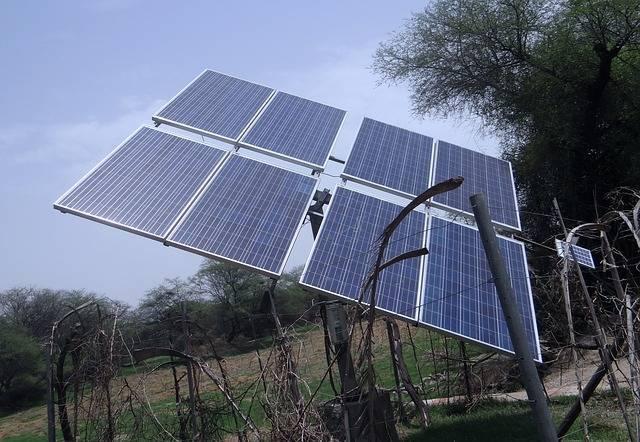
By Darshan Goswami
India needs a bold new climate and energy policy. To get there, the nation will need a new set of social and technical knowledge, transformational thinking, new policy tools, and major legislation. Here are several steps to move the country toward its Paris Accord commitment to cut greenhouse gas (GHG) emissions intensity [a measure of the global warming impact of the economy] by 33-to-35 percent, relative to 2005 levels, by 2030.
1. Introduce a carbon tax: Capturing carbon and reducing greenhouse gas emissions and planting trees could help slow and eventually reverse global warming trends.
2. Rapidly increase the deployment of renewable energy: Aggressively expand large-scale deployment of both centralized and distributed renewable energy— including solar, wind, hydro, biomass, and geothermal— to ease the strain on the present transmission and distribution system and reach more off-grid populations. Provide incentives to kickstart renewable energy programs for massive solar rooftops.
3. Develop national renewable energy (RE) policy - Enact and deploy a comprehensive new energy roadmap with innovative RE policies. In addition, set national RE standards — such as 20 percent by 2020, 40 percent by 2030, and 100 percent by 2050 — to create demand, new industries and innovation, and a new wave of green jobs.
4. Electrify transportation - Expedite a move to electrify transportation by encouraging expanded use of electric vehicles (EV) and plug-in hybrids, and deployment of solar-powered EV charging stations around the country. Develop and implement time-of-day pricing to encourage charging of vehicles at night and other times when peak demand is low. Adopt nationwide charging of electric cars from solar panels on roofs and solar-powered EV charging stations around the country. In addition, launch the public transportation system of the future with "zero-emission" battery-powered electric buses (like China is doing in their country) in all major cities to reduce air pollution, reverse climate change and global warming. India must make a massive shift that will lead to widespread adoption of EVs in the next five to seven years.
5. Energy efficiency: Promote energy efficiency in the economy, notably in industry, transportation, buildings and appliances. Make energy efficiency a high priority by expediting the development and implementation of cost-effective energy efficiency standards. To reduce the long-term demand for energy, engage states, industrial companies, utilities and other stakeholders to accelerate energy efficiency investments such as large-scale nationwide use of LED lamps.
6. Utility-scale projects - Phase out conventional energy subsidies, and develop a long-term plan to replace fossil fuel with utility-scale renewable generation. We can no longer ignore the effect of pollution and climate change on the health of our citizens.
7. Renewable innovative financing solution: Provide innovative financing (e.g., tax-free solar bonds or green infrastructure bonds) to instill more confidence from potential investors and decrease the cost of financing for renewable energy projects. Create and fund a national smart infrastructure bank to accelerate local demand for renewable energy.
8. Decentralized energy – Avoid future fossil fuel investments in India and instead emphasize nationwide deployment of community scale solar projects and micro-grids with storage. India’s present 40GW solar target should be extended to include photovoltaic panels on the rooftop of every home in India, generating enough power to reduce the country’s massive dependence on fossil fuels.
9. Micro-grids: Aggressively invest in a smart, two-way grid (and micro-grids). Invest in smart meters, as well as reliable networks that can accommodate the two-way flow of electricity.
10. Solar roadways - India should also take advantage of the vast, network of roads across India and the sun that beats down on them and turn them into energy-creating solar super highways. The idea of solar panel roads is to replace traditional asphalt roads with glass-based "solar panels that you can drive on" in a bid to turn roads into sources of renewable energy.
11. Develop energy storage: Including thermal, grid battery storage (e.g., Tesla Powerwall home battery backup), compressed air/gas, vehicles-to-grid/home, pumped hydro, fuel cells or hydrogen, flywheels, superconducting magnets and super capacitors. Develop a “hydrogen economy” plan. Recent innovations in hydrogen generation, storage, transport and use could transform it into the ultimate source of clean energy.
12. Transform India into a global solar manufacturing hub: Establish R&D facilities within academia, research institutions, industry, government and private entities to guide technology development.
India has the technical potential to meet its current power needs more than 10 times over with solar energy alone. There are no insurmountable technological or economic barriers to tapping India's vast potential to achieve 100 percent renewable energy. India can easily build a 100-percent renewable energy system at costs comparable to or less than what it would have to spend to continue its reliance on fossil and nuclear power. There is no downside to this transition. India can become the world leader and superpower in renewable energy, and eliminate pollution-related suffering of millions of people.
Darshan Goswami has more than 40 years of experience in the energy field. He worked as a project manager for renewable energy, micro-grid and smart grid projects at the United States Department of Energy (DOE) in Pittsburgh. Earlier, he was a Chief of Renewable Energy (Head) at the United States Department of Agriculture (USDA) in Washington, D.C. Mr. Goswami is a registered professional electrical engineer with a passion and commitment to promote, develop and deploy renewable energy resources and the hydrogen economy. In dedication to his life serving humanity and poor people, the author supports: India Foundation for Children Education and Care, Inc. (http://www.ifcare.org/).
TriplePundit has published articles from over 1000 contributors. If you'd like to be a guest author, please get in touch!














